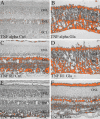Neuroinflammation in advanced canine glaucoma
- PMID: 21042562
- PMCID: PMC2965571
Neuroinflammation in advanced canine glaucoma
Abstract
Purpose: The pathophysiological events that occur in advanced glaucoma are not well characterized. The principal purpose of this study is to characterize the gene expression changes that occur in advanced glaucoma.
Methods: Retinal RNA was obtained from canine eyes with advanced glaucoma as well as from healthy eyes. Global gene expression patterns were determined using oligonucleotide microarrays and confirmed by real-time PCR. The presence of tumor necrosis factor (TNF) and its receptors was evaluated by immunolabeling. Finally, we evaluated the presence of serum autoantibodies directed against retinal epitopes using western blot analyses.
Results: We identified over 500 genes with statistically significant changes in expression level in the glaucomatous retina. Decreased expression levels were detected for large number of functional groups, including synapse and synaptic transmission, cell adhesion, and calcium metabolism. Many of the molecules with decreased expression levels have been previously shown to be components of retinal ganglion cells. Genes with elevated expression in glaucoma are largely associated with inflammation, such as antigen presentation, protein degradation, and innate immunity. In contrast, expression of many other pro-inflammatory genes, such as interferons or interleukins, was not detected at abnormal levels.
Conclusions: This study characterizes the molecular events that occur in the canine retina with advanced glaucoma. Our data suggest that in the dog this stage of the disease is accompanied by pronounced retinal neuroinflammation.
Figures







Similar articles
-
Global gene expression changes in rat retinal ganglion cells in experimental glaucoma.Invest Ophthalmol Vis Sci. 2010 Aug;51(8):4084-95. doi: 10.1167/iovs.09-4864. Epub 2010 Mar 24. Invest Ophthalmol Vis Sci. 2010. PMID: 20335623 Free PMC article.
-
Reduced AMPK activation and increased HCAR activation drive anti-inflammatory response and neuroprotection in glaucoma.J Neuroinflammation. 2018 Nov 13;15(1):313. doi: 10.1186/s12974-018-1346-7. J Neuroinflammation. 2018. PMID: 30424795 Free PMC article.
-
Retinal cell responses to elevated intraocular pressure: a gene array comparison between the whole retina and retinal ganglion cell layer.Invest Ophthalmol Vis Sci. 2010 Jun;51(6):3003-18. doi: 10.1167/iovs.09-4663. Epub 2010 Jan 13. Invest Ophthalmol Vis Sci. 2010. PMID: 20071680 Free PMC article.
-
Tools and resources for analyzing gene expression changes in glaucomatous neurodegeneration.Exp Eye Res. 2015 Dec;141:99-110. doi: 10.1016/j.exer.2015.05.009. Epub 2015 May 19. Exp Eye Res. 2015. PMID: 25999234 Free PMC article. Review.
-
Neuroinflammation in Glaucoma and Optic Nerve Damage.Prog Mol Biol Transl Sci. 2015;134:343-63. doi: 10.1016/bs.pmbts.2015.06.010. Epub 2015 Jul 10. Prog Mol Biol Transl Sci. 2015. PMID: 26310164 Review.
Cited by
-
Optical coherence tomography and molecular analysis of sudden acquired retinal degeneration syndrome (SARDS) eyes suggests the immune-mediated nature of retinal damage.Vet Ophthalmol. 2019 May;22(3):305-327. doi: 10.1111/vop.12597. Epub 2018 Aug 15. Vet Ophthalmol. 2019. PMID: 30109754 Free PMC article.
-
Analysis of Glaucoma Associated Genes in Response to Inflammation, an Examination of a Public Data Set Derived from Peripheral Blood from Patients with Hepatitis C.Clin Ophthalmol. 2022 Jun 23;16:2093-2103. doi: 10.2147/OPTH.S364739. eCollection 2022. Clin Ophthalmol. 2022. PMID: 35770250 Free PMC article.
-
Identification of pathogenic genes of pterygium based on the Gene Expression Omnibus database.Int J Ophthalmol. 2019 Apr 18;12(4):529-535. doi: 10.18240/ijo.2019.04.01. eCollection 2019. Int J Ophthalmol. 2019. PMID: 31024802 Free PMC article.
-
Primary closed angle glaucoma in the Basset Hound: Genetic investigations using genome-wide association and RNA sequencing strategies.Mol Vis. 2019 Feb 8;25:93-105. eCollection 2019. Mol Vis. 2019. PMID: 30820145 Free PMC article.
-
Meta-analysis of transcriptomic changes in optic nerve injury and neurodegenerative models reveals a fundamental response to injury throughout the central nervous system.Mol Vis. 2017 Dec 24;23:987-1005. eCollection 2017. Mol Vis. 2017. PMID: 29386873 Free PMC article.
References
-
- Grozdanic SD, Matic M, Betts DM, Sakaguchi DS, Kardon RH. Recovery of canine retina and optic nerve function after acute elevation of intraocular pressure: implications for canine glaucoma treatment. Vet Ophthalmol. 2007;10:101–7. - PubMed
-
- Ahmed F, Brown KM, Stephan DA, Morrison JC, Johnson EC, Tomarev SI. Microarray analysis of changes in mRNA levels in the rat retina after experimental elevation of intraocular pressure. Invest Ophthalmol Vis Sci. 2004;45:1247–58. - PubMed
-
- Naskar R, Thanos S. Retinal gene profiling in a hereditary rodent model of elevated intraocular pressure. Mol Vis. 2006;12:1199–210. - PubMed
-
- Steele MR, Inman DM, Calkins DJ, Horner PJ, Vetter ML. Microarray analysis of retinal gene expression in the DBA/2J model of glaucoma. Invest Ophthalmol Vis Sci. 2006;47:977–85. - PubMed
Publication types
MeSH terms
Substances
Grants and funding
LinkOut - more resources
Full Text Sources
Medical
Molecular Biology Databases
